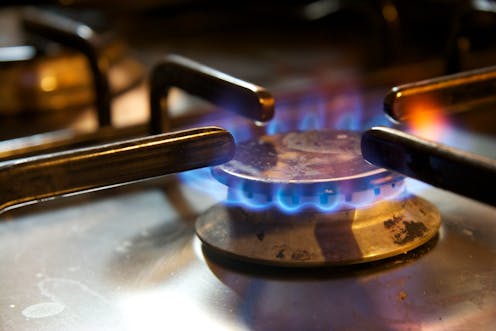
The price of gas and electricity is soaring in Britain and many millions of people are likely to be pushed into fuel poverty. And this is even with an “energy price cap”. Perhaps weirdly to many, nothing has actually gone wrong in terms of what the price cap was designed to do. But something clearly is going wrong since energy is becoming more and more unaffordable.
In short, the cap prevents the retail part of the energy supply chain (the companies that send you a bill) from making excessive profits, but places no restrictions on the production and wholesale parts. And massive increases in wholesale costs since the pandemic and the Ukraine invasion have been passed on to households (and businesses, who are not protected by the cap).
A problem upstream
To understand why there has been such a rapid rise in the “price cap”, which after all sounds like something that should be keeping prices under control, we should go back to its origins. In January 2019 the UK government introduced a price cap in the British energy retail market, applying to household users and the companies who bill them for gas and electricity (often referred to as “suppliers”). It means those companies cannot set their prices above a stated level, which is reviewed periodically (every six months so far) by the regulator, Ofgem.
Generally, the price cap has held the average annual household bill at less than £1,200. But the the cap – and therefore household bills – is now rising rapidly and, if there is no change, is expected to be more than £4,000 by early 2023.
We need to be clear about what the energy price cap was designed to do: to protect households who hadn’t secured a fixed priced contract and find themselves on a supplier’s basic variable default energy tariff. However, this protection is only in terms of ensuring people pay a “fair” retail market price (even if relative to an unfair or unaffordable wider energy market), with bills falling when suppliers’ costs do.
But there are two crucial points. First, the price cap doesn’t apply further upstream, where energy is actually produced and where most of the price rise comes from. Second, it was never designed to keep gas and electricity affordable or to offer any specific protection for those in danger of slipping into fuel poverty. The price cap is the same for every household, regardless of income.
What’s gone wrong?
Just as the price cap forces suppliers to lower the default tariff when their costs fall, it allows them to increase it when their costs rise. This flip-side is important – the first big impact of rising wholesale gas prices earlier in 2022 was when a number of smaller British energy companies providing fixed price deals went out of business, because they couldn’t pass on rising costs in time and didn’t have the financial resilience to weather the storm.
Ofgem has now decided to revisit the price cap more frequently – every three rather than every six months from the start of 2023. If supplier costs were falling, that would work better for households. When those costs are rising, due to factors further up the supply chain, regular updates to the cap will help stop suppliers going out of business but will do little to help their customers pay their bills.
How the supply chain works
Gas prices are the main problem as they affect not just gas bills, but also electricity bills, even when only a small share of electricity is generated using gas. We’ve all heard about numerous and complex constraints on energy supply, not least what’s happened to Europe’s gas supply since Russia – a major supplier of gas – invaded Ukraine. Britain doesn’t actually get much from Russia (about 4% in 2021). But that doesn’t matter, because wholesale gas prices are set on global markets and when supply is constrained, global prices rise.
Those high prices do contribute to huge profits being declared by some big energy firms – when there are supply shortages, those involved in extracting and trading fossil fuels can increase profits simply by securing a high price for their gas (and oil) on global markets. Crucially, the price cap does not apply at this stage of the supply chain, and there is no requirement to “share the gain” along with the costs.
So, what can be done?
Unfortunately, not much under the current price cap system. It only applies to the retail market, that part of the energy supply chain that households have their contracts with. The price cap is also a flat rate cap applying to all households, and it’s not designed to act as some kind of social tariff.
Our own analysis at the Centre for Energy Policy shows that lower income households are being hit hardest by the current energy price shock. The £400 Energy Grant Payment due to roll out from autumn 2022 could offset much of the direct impacts on them under the current price cap but will fall far short when the price cap and bills rocket in September and again in January.
To prevent rising poverty and an increased chance of severe recession, more direct help must be provided in the near term, perhaps along with wider emergency action. However, it is also time to revisit what the energy price cap is designed to do, and how it does it.
Karen Turner receives funding from EPSRC and InnovateUK.
This article was originally published on The Conversation. Read the original article.







